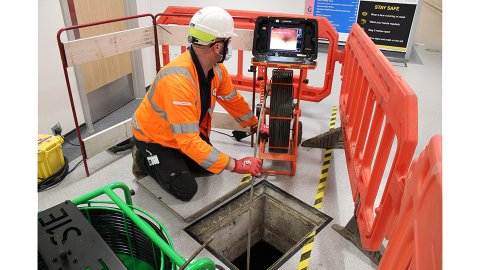
Hospitals have among the most complicated drainage systems of any built structure. They are used intensively, often 24 hours a day. They also often have legacy drainage systems, some stretching back many decades.
These are the challenges Lanes Group plc, the UK’s largest drainage specialist, is trusted to manage by hospital foundation trusts, health boards, and private health providers up and down the country.
Lanes has the capacity, expertise, experience, and technology to smoothly manage all drainage planned maintenance tasks and programmes – and react swiftly to drainage emergencies that represent a big risk to service delivery.
Most sustainable service
In terms of capacity, Lanes operates 20 depots from Aberdeen, in Scotland, to Plymouth, in Devon. It has the largest fleet of specialist jet vac tankers. These are used to clean drains and sewers with high pressure water jetting and remove it for safe and legal disposal.
Many are advanced recycler jet vac tankers, which are over 60% more productive than standard machines and more sustainable, creating smaller carbon footprints.
Lanes also operates the most modern and sophisticated fleet of CCTV drainage survey vans in the UK. The company uses the latest robotic camera systems to capture information about pipes underground or in walls, floors and ceilings.
Data is sent for processing via the cloud to a national CCTV survey centre, accelerating reporting and, again, minimising our service’s carbon footprint.
Lining legacy systems
Lanes also operates a range of other equipment that is essential for maintaining drains in sensitive healthcare environments. It includes Picote milling units which can clear blocked pipes without using water jets – in complex live environments, like hospitals and clinics, water jets may damage pipes or cause water leaks.
The company is also a national leader in ‘no dig’ remote access sewer and pipe rehabilitation, including cured in place pipe (CIPP) lining. This technique is often essential in healthcare settings, where digging up pipes and repairing, or replacing, them is just not physically possible, or will disrupt service delivery too much.
In these cases, lining pipes is often the best solution. Lanes uses an ultraviolet CIPP system which is fast, sustainable and can be carried out with least disruption. It can also now offer a new LED CIPP system. This is ideal for lining both foul and surface water vertical pipes, a process that is often the best cure for repeated blockage or leak problems.
5-point drainage plan
Given the challenges healthcare facilities managers face with site drainage systems, Lanes has devised a five-point strategy for keeping pipes flowing smoothy.
1. Know your drainage system
Carrying out a full site CCTV drainage survey, or at least sector surveys, is an essential start. For example, the Lanes Eastleigh depot, in Hampshire, has done this for a series of ambulance stations across its region. This allows plans to be updated and digitised. A firm base to plan maintenance or future development is achieved.
2. Make sure you have sufficient capacity
It is all the more alarming that an effective drainage capacity survey may not be carried out when new facilities are built. At one major hospital, regular sewage leaks were found to be caused by a too small diameter sewer being installed as part of a site upgrade. Lanes has a drainage engineering service that can assess such capacity issues.
3. Establish effective maintenance
Preventative maintenance is essential, especially because of the unique demands placed on drainage systems. Internal pipes can become blocked by debris and soap gel residue. This needs to be removed regularly. Blockage problems outside buildings can affect patient services too. Tree root infestation and drain collapses are common causes of pipe blockages.
4. Build in good drainage access
Hospital drainage systems are not always easy to access. Pipework can be installed without any access points. Manholes can be covered over during refurbishment work. A comprehensive site drainage survey will reveal these problems and provide a structured way for them to be resolved.
5. Control what goes down the drains
What patients and healthcare professionals do at home, they will do in hospital. Thousands of sanitary products and wet wipes will be disposed wrongly down hospital and clinic toilets every day. In hospital canteens and kitchens, fats and oils will find their way into drains, blocking pipes. Actively addressing these issues will reduce blockages.
Lanes Group has the know-how, expertise and technology needed by healthcare agencies, organisations and companies to intervene most effectively to address urgent drainage problems, and put in place planned maintenance to minimise the risk of them happening.